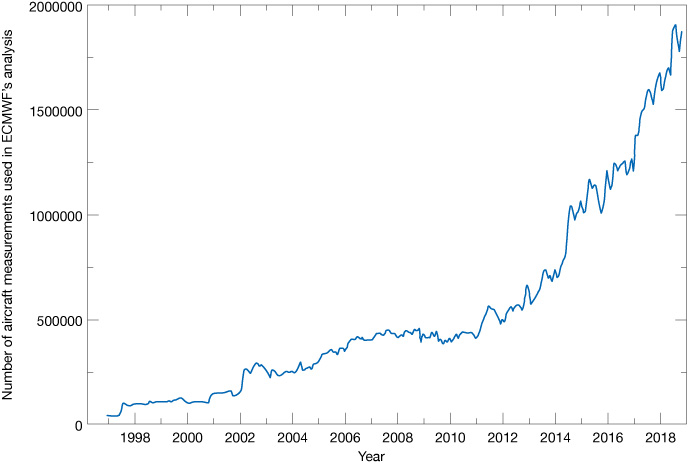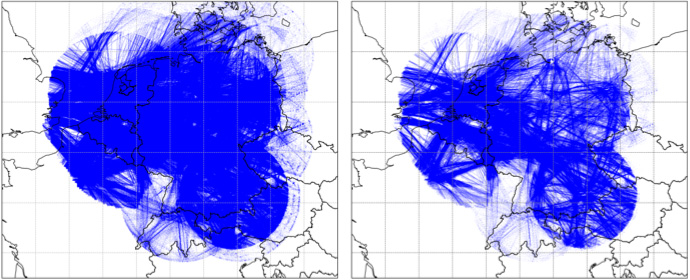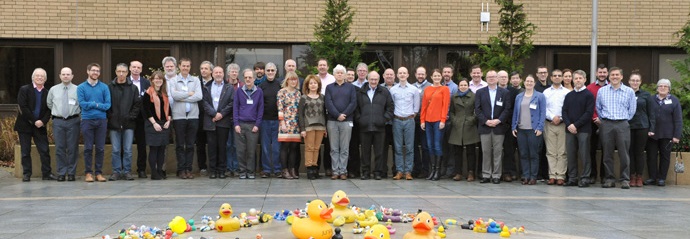

Improvements in aircraft weather observation numbers, quality and metadata are possible if numerical weather prediction centres work with the WMO, EUMETNET and the aviation sector, according to experts who met at ECMWF on 12 and 13 February 2020.
Weather reports from commercial aircraft usually contain temperature and wind and in some cases humidity and turbulence. Such observations make an important and growing contribution to the quality of weather forecasts. Together with other data, they help to estimate the state of the atmosphere at the start of forecasts.
"Aircraft data are sometimes taken for granted, perhaps because progress has been steady and continuous rather than a single big bang, but they make a hugely important contribution to the accuracy of analyses and forecasts," ECMWF Director of Research Andy Brown said as he opened the workshop.

Workshop presentations were given in ECMWF’s Council Chamber.
“These data are very valuable, but there is scope for improvements, and that is why last month we brought together 41 international experts in the field to discuss the way forward,” says ECMWF scientist Bruce Ingleby, who co-organised the workshop.
Numbers
Aircraft-based observations (ABOs) of the atmosphere have been around for a long time, and over the years they have greatly increased in number.

The number of aircraft data values used at ECMWF per day has gone up considerably over the last 20 years.
Today one of the main sources of ABOs in operational weather forecasting is the WMO’s Aircraft Meteorological Data Relay (AMDAR) programme. ECMWF receives almost a million AMDAR reports every day, many from American and European airlines, but other airlines contribute too.
More data could be useful, however, especially in some areas of the world currently not well served by AMDAR data.
A possible source is Mode-S data derived from air traffic control messages. Five million Mode-S reports are produced every day over the UK alone.
There are also some other ABO programmes, including commercial ones. “We are now wondering how to bring all these different types of observations together in a homogeneous network,” said Steve Stringer, the EUMETNET-AMDAR programme manager.

Locations and number of AMDAR temperature observations used at ECMWF in January 2020. A total of over 8.5 million observations were used to help estimate the state of the atmosphere at the start of forecasts. As shown in the chart, their geographic distribution is very uneven.
Mode-S data
Mode‐S reports provide very high‐density data, particularly winds, over parts of Europe and potentially elsewhere.
Jan Sondij from the Dutch national meteorological service (KNMI) reported on the EMADDC initiative, which makes available quality-controlled upper air observations derived from Mode-S data on an operational basis.
“A number of corrections have to be applied to derive wind and temperature data from Mode-S data in order to make them suitable for use in weather prediction,” Jan said. “We calculate correction factors that are specific to each aircraft.”

On 13 May 2019, EMADDC received about 14.6 million raw Mode-S observations over Belgium, Germany and the Netherlands provided by EUROCONTROL MUAC (left). After processing, this resulted in over 3 million quality-controlled derived observations for wind direction, wind speed and temperature (right). (Image courtesy of KNMI/EMADDC)
The EMADDC is currently processing Mode-S data operationally from EUROCONTROL MUAC for the Benelux and Germany area. Trials are ongoing with several other countries/regions within Europe.
A subset of the output observations should become available via the WMO’s Global Telecommunication System in the next year or two, with higher-density data being provided directly via a web service. ECMWF expects to start monitoring Mode-S data in 2021.
Metadata
To successfully bias-correct observations, or to stop problematic ones from being used in numerical weather prediction at all, it is useful to know from which aircraft the observations originated. This is because biases and other problems may depend on the type of aircraft used or even the specific aircraft making the measurements. There is, for example, a serious problem affecting wind directions from a subset of reports from Boeing 787 aircraft.
“Sadly, AMDAR reports give us little metadata on aircraft,” says Bruce Ingleby. A coding challenge as part of ECMWF’s Summer of Weather Code 2019 was to use online information to match AMDAR identifiers with specific aircraft and their type.
“We’ve had some success in obtaining additional metadata this way, but the system isn’t perfect,” Bruce says. “Ideally we want the airlines to provide the metadata. It would be even better, of course, if the data could be improved at source by avoiding biases and ensuring that the measurements are sufficiently accurate in the first place.”

Mean bias correction for mid-level AMDAR aircraft temperature observations (in °C) used at ECMWF in January 2020. Work at KNMI (De Haan) gives some hope that the temperature biases could be reduced by means of a better algorithm, but seeing this implemented on commercial aircraft would be a slow process.
Forecasts for aviation
“70% of delays at Heathrow are due to weather conditions,” said James Shapland, a Met Office forecaster. “If cancellations are necessary it is much better to plan this in advance than when the passengers have turned up at the airport.”
Adverse wind conditions or fog can reduce the number of take-offs per hour by 50–90%, with very large financial consequences for airlines. If an aircraft is subject to severe turbulence, then it needs a maintenance check before it can carry passengers again.
Outlook
Dean Lockett, the Scientific Officer for Aircraft and Remotely-sensed Observations at the WMO, is optimistic that over the next ten years the availability of ABOs will increase.
“Access to ABO data will be easier due to less restrictive access to onboard avionics data sources. However, this will require working with IATA, airlines, standards bodies and avionics developers,” he said.
Dean foresees an increase in the use of Mode-S data as well as a two- or threefold expansion of AMDAR data through the WMO-IATA Collaborative AMDAR Programme (WICAP).
Summarising the workshop recommendations, Steve Stringer said it was important to improve the provision of aircraft metadata; extend aircraft humidity observations; make more AMDAR data available to fill global gaps; and agree on the best way to distribute Mode-S data.
“The workshop aims included informing data users of ABO observation characteristics, informing ABO providers of detailed user requirements, and making recommendations regarding the provision or use of aircraft data,“ he said. “There was general agreement that these aims have been met.”
For more information on the workshop and to view all presentations, visit the workshop page on the ECMWF website.
More information on aircraft-based observations is available on the WMO Community Platform.

Forty-one experts took part in the two-day workshop. Full-size photo.
Top photo: Serjio74/iStock/Thinkstock
